Mushroom cultivation is an increasingly popular endeavor due to the rising demand for fresh and nutritious fungi in the culinary and medicinal industries. However, ensuring a contamination-free environment during the growing process is paramount to achieve successful yields and maintain product quality. Traditional methods of contamination detection can be time-consuming and may not always be accurate. Fortunately, the use of ultraviolet (UV) light has emerged as a valuable tool in detecting contamination in mushroom growing. This article explores how UV light is employed in the mushroom cultivation process to identify and mitigate potential risks. We made a short video about using uv light in cultivation, available on YouTube.
Understanding Contamination in Mushroom Cultivation:
Contamination is the presence of unwanted microorganisms, typically molds, bacteria, or yeasts, that compete with mushroom mycelium, hampering its growth and leading to suboptimal or even toxic mushroom production. Contamination can occur at various stages of the mushroom growing process, including during substrate preparation, inoculation, and fruiting.
The Role of UV Light in Contamination Detection:
UV light, particularly in the UVC spectrum (wavelengths ranging from 100 to 280 nm), possesses germicidal properties, effectively destroying or inactivating various microorganisms. The integration of UV light into the mushroom cultivation process allows growers to quickly and accurately identify contaminated areas, thereby preventing widespread infection and minimizing potential crop losses.
Utilizing UV Light in Mushroom Cultivation:
-
Inspection and Sterilization: Prior to inoculation, growers use UV light to inspect surfaces and equipment for signs of contamination. By exposing substrates, tools, and containers to UVC light, they can effectively sterilize these items, reducing the risk of contamination during the inoculation process.
-
Post-Inoculation Checks: After inoculating the substrate with mushroom spores or mycelium, growers use UV light to detect early signs of contamination. Infected areas may show fluorescent patterns under UV light, alerting growers to take immediate action and isolate the contaminated portions before it spreads.
-
Sterilization of Grow Rooms: UV light can be employed to sterilize the air and surfaces within grow rooms. This practice helps to minimize the presence of airborne contaminants and reduces the risk of cross-contamination between different mushroom crops.
-
Environmental Monitoring: UV light can be used in combination with specialized UV-reactive media to monitor the presence of airborne contaminants in the growing environment. The media changes color under UV light when exposed to specific contaminants, aiding in the early detection of potential issues.
Safety Considerations:
While UV light is a powerful tool for contamination detection, it is crucial to handle it with care. UVC light, in particular, can be harmful to human skin and eyes, so growers must avoid direct exposure. Specialized UV protective gear, such as goggles and gloves, should be used when working with UVC light sources.
Conclusion:
Incorporating UV light into mushroom cultivation practices provides a reliable and efficient means of detecting contamination, enabling growers to maintain clean and uncontaminated environments for optimal mushroom production. By adopting UV light as a preventive measure, mushroom growers can reduce crop losses, enhance yields, and contribute to the production of safe and high-quality mushrooms for consumers and industries alike.
